Figured it out !
Can't edit an XL Document on this PC though !!!
Will work something out !
P.
That's no any problem.
Ian
I just came across getting a TDA1541A DAC board, so I can confirm the daughter board TDA1541A logic by myself.
TDA1541A configurations:
Pin27 connected to -5V (VDD1): simultaneous mode
Pin1 LE to LLLR
Pin2 BCK to CLK
Pin3 DATAL to DL
Pin4 DATAR to DR
I2S to PCM daughter board configurations:
JOB(IO7) short (offset binary format),
all other jumpers keep open (16bit mode)
Testing went through all the conditions:
Fs: 44.1KHz, 48KHz, 88.2KHz, 96KHz, 176.4KHz, 192KHz,
MCLK: 22.579, 24.576, 45.158, 49.152 MHz,
Without and with FIFO.
It works perfect on all conditions. 192 KHz sounds much better than 44.1 KHz, impressive. This 1541 board used to work with SAA7220P digital filter, so I think it doesn’t have good NOS LPF. That might be one of the reasons. Just hope good software based up-sampling plug-in can boost 44.1K play back perfromance. That’s one of the goals of the I2S to PCM daughter board.
Some comment:
1, Continuous clock mode doesn’t work for TDA1541, has to be at stopped clock mode, no sound otherwise.
2, JTAIL and JLEAD are also no work for TDA1541, Have to keep all of them open.
3, To get better signal quality, u.fl coaxial cables are highly recommended for the connections between DAC and the daughter board
This DAC was just for confirming the PCM daughter board logic working for TDA1541. Just hope somebody else can do more research on it with higher standard 1541 DAC and better clock.
Ian
Ian,
i have connected as per the instructions above to the PCM board, but I cannot go higher than 88 (or 96) kHz sampling; above this the signal breaks up in two halves.
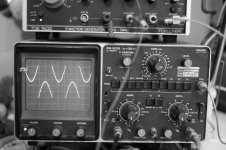
I tried with J08; and with J08 plus J06: neither works above the sampling frequency.
Source is WaveIO; I feed the isolator through a K-multiplier board and this is tapped from the PCM board. so it gets a clean 3,8V. No FIFO. Player: iTunes from Mac.
The TDA1541 +power supply worked when I had it connected to a SAA7220A
- Do you or anyone else have suggestions?
Ian,
i have connected as per the instructions above to the PCM board, but I cannot go higher than 88 (or 96) kHz sampling; above this the signal breaks up in two halves.
View attachment 544743
I tried with J08; and with J08 plus J06: neither works above the sampling frequency.
Source is WaveIO; I feed the isolator through a K-multiplier board and this is tapped from the PCM board. so it gets a clean 3,8V. No FIFO. Player: iTunes from Mac.
The TDA1541 +power supply worked when I had it connected to a SAA7220A
albert
- Do you or anyone else have suggestions?
Hi Albert,
PCM board was designed and tested up to 384KHz, so should be no any problem @88.2/96KHz.
Since you don't have a FIFO in your system, I'm a bit worry about your MCLK, where it came from? whats the frequency?
Are your using TDA1541A DAC? Did you configure it at simultaneous mode?
BTW, you will need a oscilloscope with higher bandwidth, at least 100Mhz. Otherwise it will be limited from seeing real waveform.
regards,
Ian
It may come from the TDA1541 pcb/layout as well ?!
I first used the german TDA1541 board, similar problem. Then changed from shunt to discrete and to my own board (that was made for NOS and proven to work with SAA7220). Same problem.
I have TDA1541 non-A inserted right now (is a pre-A one with separate connection, a pull from a player, with a capacitor); and it works at 88 kHz.ian said:Are your using TDA1541A DAC? Did you configure it at simultaneous mode?
My 88kHz and 96 kHz sampling frequency in simultaneous mode:
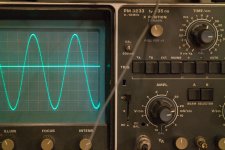
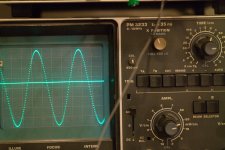
check with real TDA1541A : same problem
I have it from the bottom of the WaveIO board. Soldered thin shielded cable.Ian said:I'm a bit worry about your MCLK, where it came from? whats the frequency?
Goes to receptacle at top of board, J4, called MCLK. Thought it was a no-brainer to connect it there. :roll eyes:
Checked frequencies on input of DAC board (pin 2, CLK) and the output of WaveIO (pin going to MCLK):
Sampling freq....CLK output....... MCLK input
88 kHz .............1.588 MHz........22.578 MHz
96 kHz .............1.728 MHz .......24.578 MHz
176 kHz ...........3.176 MHz .... ..22.580 MHz
352 kHz ...........zero ....... ......22.578 MHz
I have jumper I05-IO6 (HALF) open initially; closed it, and this give no difference on lack of output, the zero CLK and is like the table above.
hope this helps in pinpointing the issue.
At highest speed there is no output from dac. (no CLK either)
Last edited:
It may come from the TDA1541 pcb/layout as well ?!
Eldam, I have a straight connection from pin to landing strip. No attenuators.
Hi Albert,
Did you get the AYA II board as I advised you in our last conversation once year ago (more or less) ? It is proven to work at 192 K hz with the first Wave I/O which was limited to 192 K Hz (the Wave I/O). This pcb should work at 380 K Hz (Ask for instance to Supra member which had the wave I/O, Ian's front end line, AYA II 2014, and Crystek 44/45 XOs ?). Since Lorien with Ian has solved the issues if I remember on the Wave I/O... at least you may use the non isolated side with uf-l plugs for a perfect connection with Fifo/isolator/clock/pcm combos . Or even with the Wave I/O and the PCM board only : uf-l connection only at these speeds).
Ian said me even the PCM is ok with 380 upsampled material on his TDA1541 board...).
I had also myself some problem because the connection of the clocks adaptators on the tulipe DIP12 of the clock boards had a non enough solid connection (if you force a little the pins to improve the coupling, it's ok with and without the decoupling at the bottom of the adaptators clock boards !)
I have also a tda1541 non A but it is marqued Y and I have a doubt about the signification of it (I even read some non A worked only with an external DEM timing cap
 ).
).
You may have a layout problem somewhere, not sure it is about your own pcb...
Ask also to Lorien if your firmaware version is 352/380 K Hz enable (you may need to upgrade the eprom with a Windows pcb)
With Simultaneous board and your 22 M Hz Crystal you need iirc to strap your PCM in half speed mode as well.
Did you always heard your MAC usb outputt plays 352 upsampling material ?
Did you get the AYA II board as I advised you in our last conversation once year ago (more or less) ? It is proven to work at 192 K hz with the first Wave I/O which was limited to 192 K Hz (the Wave I/O). This pcb should work at 380 K Hz (Ask for instance to Supra member which had the wave I/O, Ian's front end line, AYA II 2014, and Crystek 44/45 XOs ?). Since Lorien with Ian has solved the issues if I remember on the Wave I/O... at least you may use the non isolated side with uf-l plugs for a perfect connection with Fifo/isolator/clock/pcm combos . Or even with the Wave I/O and the PCM board only : uf-l connection only at these speeds).
Ian said me even the PCM is ok with 380 upsampled material on his TDA1541 board...).
I had also myself some problem because the connection of the clocks adaptators on the tulipe DIP12 of the clock boards had a non enough solid connection (if you force a little the pins to improve the coupling, it's ok with and without the decoupling at the bottom of the adaptators clock boards !)
I have also a tda1541 non A but it is marqued Y and I have a doubt about the signification of it (I even read some non A worked only with an external DEM timing cap
 ).
).You may have a layout problem somewhere, not sure it is about your own pcb...
Ask also to Lorien if your firmaware version is 352/380 K Hz enable (you may need to upgrade the eprom with a Windows pcb)
With Simultaneous board and your 22 M Hz Crystal you need iirc to strap your PCM in half speed mode as well.
Did you always heard your MAC usb outputt plays 352 upsampling material ?
Last edited:
Hi Albert,
Since Lorien with Ian has solved the issues if I remember on the Wave I/O... at least you may use the non isolated side with uf-l plugs for a perfect connection with Fifo/isolator/clock/pcm combos . Or even with the Wave I/O and the PCM board only : uf-l connection only at these speeds).
Ian said me even the PCM is ok with 380 upsampled material on his TDA1541 board...).
I had also myself some problem because the connection of the clocks adaptators on the tulipe DIP12 of the clock boards had a non enough solid connection (if you force a little the pins to improve the coupling, it's ok with and without the decoupling at the bottom of the adaptators clock boards !)
You may have a layout problem somewhere, not sure it is about your own pcb...
With Simultaneous board and your 22 M Hz Crystal you need iirc to strap your PCM in half speed mode as well.
Did you always heard your MAC usb outputt plays 352 upsampling material ?
No, I missed the AYA board rerun. Have not done a lot for a long timeDid you get the AYA II board
because the clock signal disappears, this can well be the issue. I will contact Lorien.Ask also to Lorien if your firmaware version is 352/380 K Hz enable (you may need to upgrade the eprom with a Windows pcb)
Correct, I collected Philips players (Piekfijn), and these often contained the non-A with a capacitor.I have also a tda1541 non A but it is marqued Y and I have a doubt about the signification of it (I even read some non A worked only with an external DEM timing cap
).
I tried to solder the plugs but they are a real disaster for a DIY.you may use the non isolated side with uf-l plugs
Ian,
i have connected as per the instructions above to the PCM board, but I cannot go higher than 88 (or 96) kHz sampling; above this the signal breaks up in two halves.
View attachment 544743
I tried with J08; and with J08 plus J06: neither works above the sampling frequency.
Source is WaveIO; I feed the isolator through a K-multiplier board and this is tapped from the PCM board. so it gets a clean 3,8V. No FIFO. Player: iTunes from Mac.
The TDA1541 +power supply worked when I had it connected to a SAA7220A
albert
- Do you or anyone else have suggestions?
Hi Albert,
Can you post a picture of your PCM board /1541DAC hookup to see if I have any suggestion?
Regards,
Ian
Any uf-l wire to connect the MCLK non isolated uf-l plug from the Wave I/O to the uf-l one of the PCM board to try if the 352 K Hz is working (with strap for half mode speed ? I even don't remember the clock speed of the Wave I/O!) ?
Wave IO 22/24 MHz MCLK if I'm not wrong.
Ian
Hi Albert,
Can you post a picture of your PCM board /1541DAC hookup to see if I have any suggestion?
Regards,
Ian
Ian, I shame myself for what I am going to post, but I have some consolation knowing many out there work like this :roll eyes:
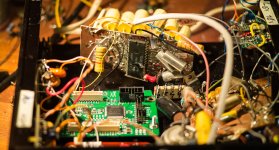
One Ufl has a plug (i was only able to get one soldered, all others failed on me) while two have a uff cable only and one (the latch enable) has no shield.
Shields are connected both sides.
I thought the shielded cables were better than the one with the plug which is not shielded (black if I remember) , but I have been thinking of reverting to the plug you supplied with the attached cable.
Well, it gets to a mess once one starts fooling around
Back in December 2013, I connected an I2S-PCM board between a WaveIO and my diy tda1541a dac and also could not get it to work properly with music with a sampling rate higher than 96kHz. I puzzled over it for a while and wrote about it on this forum (post #603 to #622) but there was no resolution. Then I installed the FIFO, isolator, and clock boards and 192kHz music played successfully. I did not do anything other than install the FIFO, isolator, and clock boards.
Ian thought the problem may have been caused by a ground loop and EMC noise, and that was cut by the addition of the isolator.
I eventually upgraded the crystal oscillators to the higher frequency Crysteks and even though with the higher frequency clocks I should have been able to play 352.8kHz and 384kHz material, all I could get was music masked by a lot of noise. Since the ability to play material of these frequencies was not critical to me, I didn't pursue the matter further.
Perhaps my issues with I2S-PCM board and tda1541a dac and higher than 96kHz material may shed some light on the matter.
My layout and wiring:
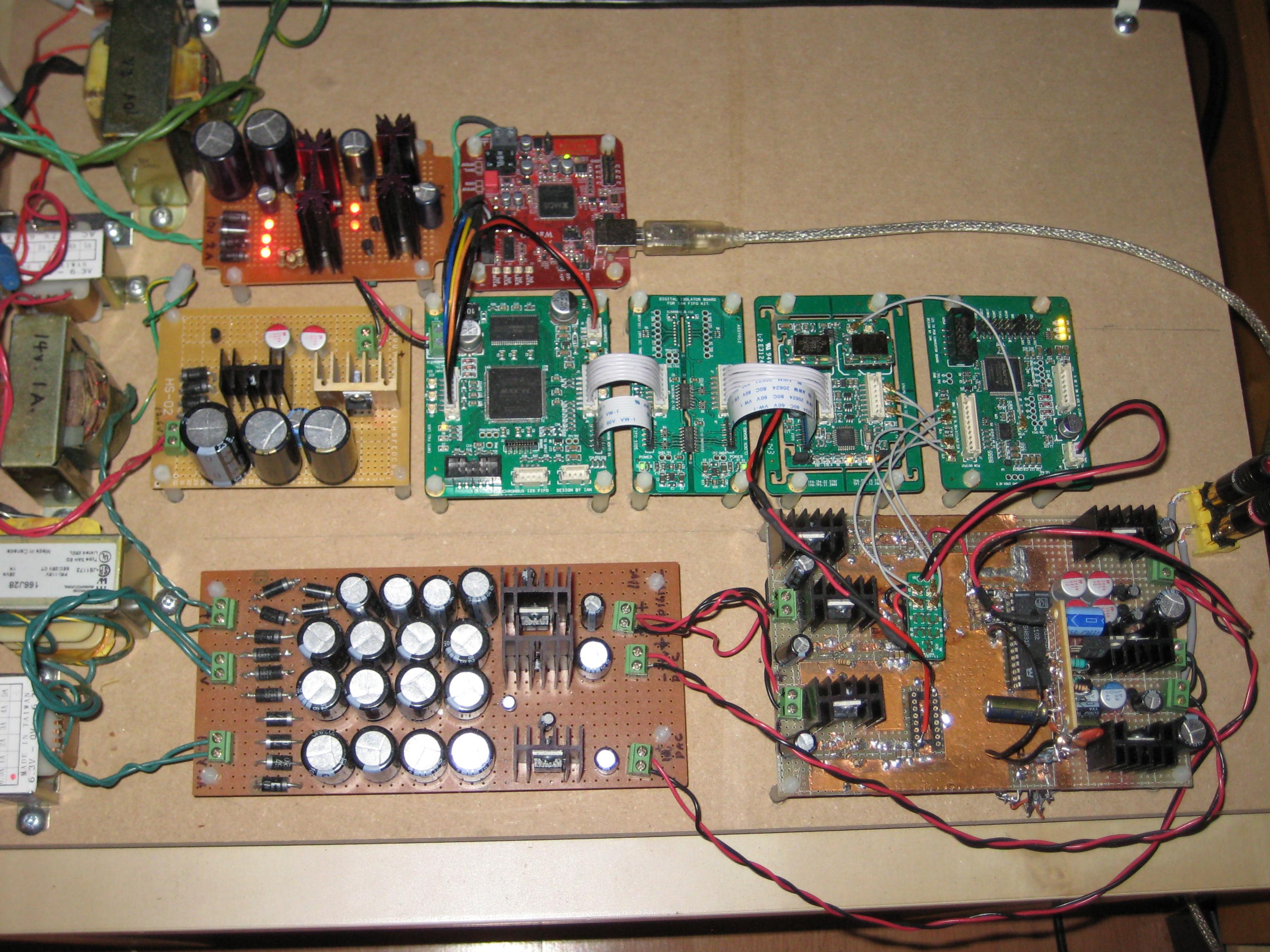
Ian thought the problem may have been caused by a ground loop and EMC noise, and that was cut by the addition of the isolator.
I eventually upgraded the crystal oscillators to the higher frequency Crysteks and even though with the higher frequency clocks I should have been able to play 352.8kHz and 384kHz material, all I could get was music masked by a lot of noise. Since the ability to play material of these frequencies was not critical to me, I didn't pursue the matter further.
Perhaps my issues with I2S-PCM board and tda1541a dac and higher than 96kHz material may shed some light on the matter.
My layout and wiring:

Do you or anyone else have suggestions?
albert
Mac based with WaveIO... I think Eldam is onto something.. if you have an early version of WaveIO and haven't updated the firmware, there will be timing errors which will become apparent at higher sampling frequencies. Fortunately addressed by Ian and implemented by Lucian in the PC (platform only unfortunately) downloadable update.
But still 192k was no problem with the earliest WaveIO to 1541A via Ians PCM board so perhaps something else (if you're limited to 96k).
Update firmware and be sure that the jumper selection is correct as per Ian PCM.pdf for use with the clocks on the WaveIO, Ian is correct about their frequencies.
More info about the I2S timing errors and impact on higher sampling rates to be found around ie; http://www.diyaudio.com/forums/digi...project-ultimate-weapon-fight-jitter-335.html
LH/S
Last edited:
Ludwig,Mac based with WaveIO... I think Eldam is onto something.. if you have an early version of WaveIO and haven't updated the firmware, there will be timing errors which will become apparent at higher sampling frequencies. Fortunately addressed by Ian and implemented by Lucian in the PC (platform only unfortunately) downloadable update.
But still 192k was no problem with the earliest WaveIO to 1541A via Ians PCM board so perhaps something else (if you're limited to 96k).
Update firmware and be sure that the jumper selection is correct as per Ian PCM.pdf for use with the clocks on the WaveIO, Ian is correct about their frequencies.
More info about the I2S timing errors and impact on higher sampling rates to be found around ie; http://www.diyaudio.com/forums/digi...project-ultimate-weapon-fight-jitter-335.html
LH/S
I also thought about the USB cable. The standard cables are not shielded, and even not twisted like CAT6. So I made a cable, a short one, based on Cat6. But no improvement.
What i wil test today is some beads.
I have a separate chassis for the transformers. So the 1 meter cable gives all the chance for coupling of the earth wires . . .

192 kHz is OK for me, I have a filter for that. The 88 kHz simultaneous mode is so incredibly clear (clear steps without any latency between the bit levels), I will post an example.
I have a PM for Lucian. I use a 2015 board if I am correct.
If you're happy then I have no argument!!
Hey, do I recall that you had implemented a 'Kondo' style filter at the output of your D/A - pr was that someone else??... - I'd be keen to see it, if its available.. otherwise agree with Ian that higher Fs mitigates the need for such.
LH/S
Hey, do I recall that you had implemented a 'Kondo' style filter at the output of your D/A - pr was that someone else??... - I'd be keen to see it, if its available.. otherwise agree with Ian that higher Fs mitigates the need for such.
LH/S
I read now that the WaveIO is enabled to 192 kHz, thus I have to accept that limit.. But for now I am stuck with 88 kHz.If you're happy then I have no argument!!
Hey, do I recall that you had implemented a 'Kondo' style filter at the output of your D/A - pr was that someone else??... - I'd be keen to see it, if its available.. otherwise agree with Ian that higher Fs mitigates the need for such.
LH/S
Condo: Thanks for remarking this. I will revisit this Kondo filter again and show my results; I have it in my DAC-player.
First prio is getting this USB stuff into 'production' (the living room).
albert
Anyway I will not be worry about USB as far your Wave I/O is powered by a clean 5V and you use the isolated side !
Surely the layout of the dac chip pcb.
If I understood your photograph, the yellow wire is TDA I2S pin 1. Is it shielded ?
In anaother way, I2S wires are very shorts which could not be bad even if the yellow wire LRCK is not a 50 ohms (?) at this length and not so high speeds (?). I say that because the yellow one looks like a 100 ohms network cable (?)....
maybe a Gnd pb of the TDA1541 pcb ? Mainly the MCLK connections between Wave I/O and PCM board and quality of BcK connection (and gnd layout) between PCM and dac chip board.
If I remember the 2015 Wave I/O is ok for 354/380 speeds. Just need maybe the half-speed strap on the PCM board as crystals are 21/24xxx on the Wave I/O !
Surely the layout of the dac chip pcb.
If I understood your photograph, the yellow wire is TDA I2S pin 1. Is it shielded ?
In anaother way, I2S wires are very shorts which could not be bad even if the yellow wire LRCK is not a 50 ohms (?) at this length and not so high speeds (?). I say that because the yellow one looks like a 100 ohms network cable (?)....
maybe a Gnd pb of the TDA1541 pcb ? Mainly the MCLK connections between Wave I/O and PCM board and quality of BcK connection (and gnd layout) between PCM and dac chip board.
If I remember the 2015 Wave I/O is ok for 354/380 speeds. Just need maybe the half-speed strap on the PCM board as crystals are 21/24xxx on the Wave I/O !
Thanks, Eldam,Anyway I will not be worry about USB as far your Wave I/O is powered by a clean 5V and you use the isolated side !
Surely the layout of the dac chip pcb.
If I understood your photograph, the yellow wire is TDA I2S pin 1. Is it shielded ?
In another way, I2S wires are very shorts which could not be bad even if the yellow wire LRCK is not a 50 ohms (?) at this length and not so high speeds (?). I say that because the yellow one looks like a 100 ohms network cable (?)....
the yellow wire is single strand wire, for LE, not isolated at all, and I thought for this low speed it would be OK. Thinking about it, the rising edge is a timing edge and is fast of course. . will make a shielded one.
The ground is a plane and give the cleanest output I have seenmaybe a Gnd pb of the TDA1541 pcb ?
I willstop pursuing 352 etc.If I remember the 2015 Wave I/O is ok for 354/380 speeds. Just need maybe the half-speed strap on the PCM board as crystals are 21/24xxx on the Wave I/O !
I suspect a problem here: everyone uses the isolated outs from WaveIO and then connects a non-isolated MCLKMainly the MCLK connections between Wave I/O and PCM board and quality of BcK connection (and gnd layout) between PCM and dac chip board.
How did you do it?
albert
I suspect a problem here: everyone uses the isolated outs from WaveIO and then connects a non-isolated MCLK
How did you do it?
albert
I was wrong in this wild idea: the Mclock on WaveIO after isolator goes to Ians's card.
+ I now used an isolated cable for the LE.
+ I inserted inductors in all entering power lines (not just the earths).
+ and I added a parallel choke on the WaveIO power feed.
And my Macbook is always running from batteries.
Nothing helped.
- Home
- Source & Line
- Digital Line Level
- Drive NOS AD1865/62,PCM1704/02/63,TDA1541 from FIFO: Universal I2S-PCM driver board